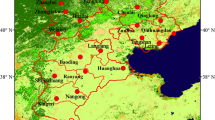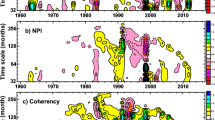Abstract
Change point analysis is an efficient tool to understand the fundamental information in hydro-meteorological data such as rainfall, discharge, temperature etc. Especially, the result of a reasonable change point detection method can be effectively used in the prediction of flood and drought because it provides a key to resolve the non-stationary or inhomogeneous problem by climate change. However, relatively few studies have addressed the performance of the change point detection skills through comparative study and applications using real data. Therefore, in this study, the comparative study to assess the performance of the three change point detection skills; Cumulative Sum (CUSUM) method, Bayesian Change Point (BCP) method, and segmentation by Dynamic Programming (DP) was performed. After assessment of the performance of the proposed detection skills, the two reasonable detection skills were applied to the observed and future rainfall data at the 5 rainfall gauges in South Korea. The three types of the synthetic rainfall data, homogeneous series and inhomogeneous series with a single shift and multiple shifts were generated firstly to assess performance of the detection skills. Especially, the exact number of change points, position error of detected change points and the three indicators were used to assess performance of each detection skill. Finally, it was suggested that BCP (with 0.9 posterior probability) could be best detection skill and DP could be reasonably recommended through the comparative study. Also it was suggested that BCP (with 0.9 posterior probability) and DP detection skills to find some change points could be reasonable at the North-eastern part in South Korea. In future, the results in this study can be efficiently used to resolve the non-stationary problems in water resources management and design of hydraulic structures.
Similar content being viewed by others
References
Abdul Aziz, O. I. and Burn, D. H. T. (2006). “Trends and variability in the hydrological regime of the Mackenzie River Basin.” Journal of Hydrology, Vol. 319, Issues 1–4, pp. 282–294, DOI: 10.1016/j.jhydrol.2005.06.039.
Aksoy, H., Gedikli, A., Unal, N. E. M and Kehagias, A. (2008). “Fast segmentation algorithms for long hydrometeorological time series.” Hydrological Processes, Vol. 22, No. 23, pp. 4600–4608, DOI: 10.1002/hyp.7064.
Andersen, T., Carstensen, J., Hernandez-Garcia, E., and Duarte, C. M. (2009). “Ecological thresholds and regime shifts: Approaches to identification.” Trends Ecol. Evol., Vol. 24, No. 1, pp. 49–57, DOI: 10.1016/j.tree.2008.07.014.
Barry, D. and Hartigan, J. A. (1992). “Product partition models for change point problems.” The Annals of Statistics, Vol. 20, No. 1, pp. 260–279, DOI: 10.1214/aos/1176348521.
Barry, D. and Hartigan, J. A. (1993). “A bayesian analysis for change point problems.” Journal of the American Statistical Association, Vol. 88, No. 421, pp. 309–319, DOI: 10.2307/2290726.
Bassevilee, M. and Nikiforov, I. V. (1993). Detection of abrupt changes: Theory and application, PRT Prentice Hall, New York.
Beaulieu, C., Seidou, O., Ouarda, B. M. J., and Zhang, X. (2009). “Intercomparison of homogenization techniques for precipitation data continued: Comparison of two recent Bayesian change point models.” Water Resources Research Vol. 45, W08410, DOI: 10.1029/2006WR005615.
Bernardo, J. M. and Smith, A. F. (1994). Bayesian theory, ohn Wiley & Sons, New York.
Box, G. E. P. and Tiao, G. C. (1962). “A further look at robustness via Bayes’ theorem.” Biometrika, Vol. 49, Nos. 3–4, pp. 419–432, DOI: 10.2307/2333976.
Burn, D. H. (1994). “Hydrologic effects of climatic change in West Central Canada.” Journal of Hydrology, Vol. 160, Issues 1–4, pp. 53–70, DOI: 10.1016/0022-1694(94)90033-7.
Carlin, B. P., Gelfand, A. E., and Smith, A. F. M. (1992). “Hierarchical Bayesian analysis of changepoint problems.” Applied Statistics, Vol. 41, No. 2, pp. 389–405, DOI: 10.2307/2347570.
Carslaw, D. C., Ropkins, K., and Bell, M. C. (2006). “Change-point detection of gaseous and particulate traffic-related pollutants at a roadside location.” Environ. Sci. Techno., Vol. 40, No. 22, pp. 6912–6918, DOI: 10.1021/es060543u.
Chelani, A. B. (2011). “Change detection using CUSUM and modified CUSUM method in air pollutant concentrations at traffic site in Delhi.” Stochastic Environmental Research and Risk Assessment, Vol. 25, pp. 827–834, DOI: 10.1007/s00477-010-0452-6.
Chib, S. (1998). “Estimation and comparison of multiple change-point models.” Journal of Econometrics, Vol. 86, Issue 2, pp. 221–241, DOI: 10.1016/S0304-4076(97)00115-2.
Chowdhury, R. K. and Beecham, S. (2010). “Australian rainfall trends and their relation to the southern oscillation index.” Hydrological Processes, Vol. 24, No. 4, pp. 504–514, DOI: 10.1002/hyp.7504.
Chu, H. J., Pan, T. Y., and Liou, J. J. (2012). “Change-point detection of long-duration extreme precipitation and the effect on hydrologic design: a case study of South Taiwan.” Stochastic Environmental Research and Risk Assessment, Vol. 26, pp. 1123–1130, DOI: 10.1007/s00477-012-0566-0.
Collins, W. J., Bellouin, N., Doutriaux-Boucher, M., Gedney, M., Hinton, T., Jones, C. D., Liddicoat, S., Martin, G., O’Connor, F., Rae, J., Senior, C., Totterdell, I., Woodward, S., Reichler, T., and Kim, J. (2008). “Evaluation of HadGEM2 model.” Hadley Centre Technical Note, Vol. 74, p. 44.
Dobigeon, N. and Tourneret, J. Y. (2007). “Joint segmentation of wind speed and direction using a hierarchical model.” Comput. Statist. Data Anal., Vol. 51, Issue 12, pp. 5603–5621, DOI: 10.1016/j.csda.2007.04.016.
Domonkos, P. (2011). “Efficiency evaluation for detecting inhomogeneities by objective homogenization methods.” Theoretical and Applied Climatology, Vol. 105, Nos. 3–4, pp. 455–467, DOI: 10.1007/s00704-011-0399-7.
Efron, B. and Tibshirani, R. J. (1993). An introduction to the bootstrap, Chapman & Hall, New York.
Erdman, C. and Emerson, J. C. (2007). “BCP: An R package for performing a Bayesian analysis of change point problems.” Journal of Statistical Software, Vol. 23, No. 3, pp. 1–13.
Fearnhead, P. (2006). “Exact and efficient Bayesian inference for multiple changepoint problems.” Statistics and Computing, Vol. 16, pp. 203–213, DOI: 10.1007/s11222-006-8450-8.
Fearnhead, P. and Liu, Z. (2011). “Efficient Bayesian analysis of multiple changpoint models with dependence across segments.” Statistics and Computing, Vol. 21, pp. 217–229, DOI: 10.1007/s11222-009-9163-6.
Gedikli, A., Aksoy, H., and Unal, N. E. (2008). “Segmentation algorithm for long time series analysis.” Stochastic Environmental Research and Risk Assessment, Vol. 22, pp. 291–302, DOI: 10.1007/s00477-007-0115-4.
Gedikli, A., Aksoy, H., and Unal, N. E. (2010). “AUG-Segmenter: A user-friendly tool for segmentation of long time series.” Journal of Hydroinformatics, Vol. 12, No. 3, pp. 318–328, DOI: 10.2166/hydro.2009.084.
Gedikli, A., Aksoy, H., Unal, N. E., and Kehagias, A. (2010). “Modified dynamic programming approach for offline segmentation of long hydrometeorological time series.” Stochastic Environmental Research and Risk Assessment, Vol. 24, pp. 547–557, DOI: 10.1007/s00477-009-0335-x.
Hartigan, J. A. (1990). “Partition models.” Communications in Statistics Vol. 19, Issue 8, pp. 2745–2756.
Hirsch, R. M., Slack, J. R., and Smith, R. A. (1982). “Techniques of trend analysis for monthly water quality data.” Water Resources Research, Vol. 18, Issue 1, pp. 107–121, DOI: 10.1029/WR018i001p00107.
Hurbert, P. (2000). “The segmentation procedure as a tool for discrete modeling of hydrometeorological regimes.” Stochastic Environmental Research and Risk Assessment, Vol. 14, Issues 4–5, pp. 297–304, DOI: 10.1007/PL00013450.
Hurst, H. E. (1951). “pLong term storage capacity of reservoirs.” Transactions of the American Society of Civil Engineers, Vol. 116, pp. 776–808.
Kampata, J. M., Parida, B. P., and Moalafhi, D. B. (2008). “Trend analysis of rainfall in the headstreams of the Zambezi river basin in Zambia.” Phys. Chem. Earth, Vol. 33, Issues 8–13, pp. 621–625, DOI: 10.1016/j.pce.2008.06.012.
Kavetski, D., Kuczera, G., and Franks, S. W. (2006). “Bayesian analysis of input uncertainty in hydrological modeling: 1. Theory.” Water Resources Research, Vol. 42, W03407, DOI: 10.1029/2005WR0043-8.
Kehagias, A., Nidelkou, E., and Petridis, V. (2006). “A dynamic programming segmentation procedure for hydrological and environmental time series.” Stochastic Environmental Research and Risk Assessment, Vol. 20, pp. 77–94, DOI: 10.1007/s00477-005-0013-6.
Kim, J. and Cheon, S. (2010). “Bayesian multiple change-point estimation with annealing stochastic approximation Monte Carlo.” Computational Statstics, Vol. 25, pp. 215–239, DOI: 10.1007/s00180-009-0172-x.
Kim, S. U. and Lee, K. S. (2010). “Regional low flow frequency analysis using Bayesian regression and prediction at ungauged catchment in Korea.” KSCE Journal of Civil Engineering, KSCE, Vol. 14, No. 1, pp. 87–98, DOI: 10.1007/s12205-010-0087-7.
Kim, C., Suh, M. S., and Hong, K. O. (2009). “Bayesian changepoint analysis of the annual maximum of daily and subdaily precipitation over South Korea.” Journal of Climate, Vol. 22, Issues 24, pp. 6741–6757, DOI: 10.1175/2009JCLI2800.1.
Kleiner, Y. and Rajani, B. (2012). “Comparison of four models to rank failure likelihood of individual pipes.” Journal of Hydroinfomatics, Vol. 14, No. 3, pp. 659–681, DOI: 10.2166/hydro.2011.029.
Lee, K. S. and Kim, S. U. (2008). “Identification of uncertainty in low flow frequency analysis using Bayesian MCMC method.” Hydrological Processes, Vol. 22, Issue 12, pp. 1949–1964, DOI: 10.1002/hyp.6778.
Li, Z. L., Xu, Z. X, Li, J. Y., and Li, Z. J. (2008). “Shift trend and step changes for runoff time series in the Shiyang River basin, northwest China.” Hydrological Processes, Vol. 22, No. 23, pp. 4639–4646, DOI: 10.1002/hyp.7127.
Lins, H. F. and Cohn, T. A. (2011). “Stationarity: Wanted dead or alive?.” American Water Resources Association, Vol. 47, No. 3, pp. 475–480, DOI: 10.1111/j.1752-1688.2011.00542.x.
Milly, P. C. D., Betancourt, J., Falkernmark, M., Hirsch, R. M., Kundzewicz, Z. W., Lettenmaier, D. P., and Stouffer, R. J. (2008). “Stationarity is dead: Whither water management?” Science, Vol. 319, pp. 573–574, DOI: 10.1126/science.1151915.
Page, E. S. (1954). “Continuous inspection scheme.” Biometrika, Vol. 41, Issuess 1–2, pp. 100–115, DOI: 10.1093/biomet/41.1-2.100.
Perreault, L., Bernier, J., Bobée, B., and Parent, E. (2000a). “Bayesian change-point analysis in hydrometeorological time series. Part 1. The normal model revisited.” Journal of Hydrology, Vol. 235, Issue 3–4, pp. 221–241, DOI: 10.1016/S0022-1694(00)00270-5.
Perreault, L., Bernier, J., Bobée, B., and Parent, E. (2000b). “Bayesian change-point analysis in hydrometeorological time series. Part 2. Comparison of change-point models and forecasting.” Journal of Hydrology, Vol. 235, Issues 3–4, pp. 242–263, DOI: 10.1016/S0022-1694(00)00271-7.
Rao, A. R. and Tirtotjondro, W. (1996). “Investigation of changes in characteristics of hydrological time series by Bayesian method.” Stochastic Hydrology and Hydraulics, Vol. 10, pp. 295–317, DOI: 10.1007/BF01581871.
Reis Jr., D. S. and Stedinger, J. R. (2005). “Bayesian MCMC flood frequency analysis with historical information.” Journal of Hydrology, Vol. 313, Issues 1–2, pp. 97–116, DOI: 10.1016/j.jhydrol.2005.02.028.
Shehadeh, N. and Ananbeh, S. (2013). “The impact of climate change upon winter rainfall.” American Journal of Environmental Science, Vol. 9, No. 1, pp. 73–81, DOI: 10.3844/ajessp.2013.73.81.
Taylor, C. H. and Loftis, J. C. (1989). “Testing for trend in lake and groundwater quality time series.” Water Resources Bulletin, Vol. 24, No. 4, pp. 715–726, DOI: 10.1111/j.1752-1688.1989.tb05385.x.
Walters, D. N., Best, M. J., Bushell, A. C., Copsey, D., Edwards, J. M., Fallon, P. D., Harris, C. M., Lock, A. P., Manners, J. C., Morcrette, C. J., Roberts, M. J., Stratton, R. A., Webster, S., Wilkinson, J. M., Willett, M. R., Boutle, I. A., Moufouma-Okia, W., Palmer, M. D., Petch, J. C., Rooney, G. G., Scaife, A. A., and Williams, K. D. (2011). “The met office unified model global atmosphere 3.0/3.1 and JULES global land 3.0/3.1 configurations.” Geoscientific Model Development, Vol. 4, No. 4, pp. 919–941, DOI: 10.5194/gmd-4-919-2011.
Wei, S., Zuo, D., and Song, J. (2012). “Improving prediction accuracy of river discharge time series using a Wavelet-NAR artificial neural network.” Journal of Hydroinformatics, Vol. 14, No. 4, pp. 974–991, DOI: 10.2166/hydro.2012.143.
Yao, Y. C. (1984). “Estimation of a noisy discrete-time step function: Bayes and empirical Bayes approaches.” The Annals of Statistics, Vol. 12, No. 4, pp. 1434–1447, DOI: 10.1214/aos/1176346802.
Zhao, X. and Chu, P. S. (2006). “Bayesian multiple changepoint analysis of hurricane activity in the Eastern North Pacific: A Markov Chain Monte Carlo approach.” Journal of Climate, Vol. 19, pp. 564–578, DOI: 10.1175/JCLI3628.1.
Author information
Authors and Affiliations
Corresponding author
Rights and permissions
About this article
Cite this article
Lee, S., Kim, S.U. Comparison between change point detection methods with synthetic rainfall data and application in South Korea. KSCE J Civ Eng 20, 1558–1571 (2016). https://doi.org/10.1007/s12205-014-0228-5
Received:
Revised:
Accepted:
Published:
Issue Date:
DOI: https://doi.org/10.1007/s12205-014-0228-5




